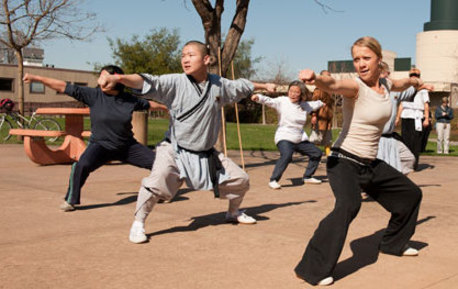由2011年冬季學期開始,斯坦福大學開設了一門少林功夫課。這門課基本上是一個功夫班,由少林寺和尚執教。少林功夫課,由斯坦福大學“健康改進計劃”開辦。計劃的經理杰莉·菲曼說,一名斯坦福大學的雇員建議她開辦功夫班,并且請少林寺和尚任教,于是她研究了設在舊金山的“美國少林寺”所教授的少林功夫,發現不錯,于是將其引進斯坦福大學。
功夫班由釋延然師傅執教,他今年30歲,自9歲起就在嵩山少林寺學功夫。另外還有六位17歲至27歲的少林和尚擔任助教。上課地點是醫學院辦公大樓后面的一個庭院,每周上課一小時。功夫班的目的是透過練功,達到身心的健康與平衡。菲曼說,不少人都對功夫班感興趣,因此會繼續辦下去。去年冬季學期,有17人報名上課,今春則有22人。報名者無須學過武術,也不論年齡和體能,報名費要100美元,如果回答問卷還可以減收20美元。

|
 |
|
Lisa Becker, a biology research assistant, learns Shaolin Kung Fu from the masters in the class at Stanford. |
Master Shi Yanran has performed kung fu all over the world – with the Shaolin Temple Kung Fu Monks Corps, in the theatrical extravaganza Shaolin: Wheel of Life, and with contemporary ballet dancers in Long River High Sky.
In 2010, he was named martial artist of the year at the 12th World Congress on Qigong and Traditional Chinese Medicine, which was held in San Francisco.
Yet here he was, a Buddhist monk ordained at the legendary Songshan Shaolin Temple in central China, striding into a Stanford campus courtyard, ready to teach a mind-body fitness class sponsored by the university's Health Improvement Program.
He wore a cinnamon-brown robe with a sparkling name – a "triple jewel robe." It signifies that he has accepted the three gems of the spiritual life – the Buddha, the teachings of Buddha and the monastic Buddhist community.
Master Yanran was accompanied by six monks, ranging in age from 18 to 27, who wore light blue, belted robes, trimmed in black, bearing the embroidered logo of Shaolin Temple USA, which is headquartered in San Francisco. The logo shows the front gate of the Songshan Shaolin Temple, which is revered as the birthplace of Chan (Zen) Buddhism and as the cradle of Shaolin Kung Fu.
Their students – wearing T-shirts, loose-fitting pants and athletic shoes – soon converged on the courtyard for the weekly hour-long class, which takes place in a courtyard behind the Medical School Office Building on Welch Road.
Paula Bailey, an education coordinator at the Center for Biomedical Ethics, arrived with a straight sword, its blade resting safely inside a garnet-red scabbard.
Paochen Zhang, an administrative associate in the research lab at Stanford Blood Center, carried a slender wooden staff grasped firmly in one hand.
Kathleen Guan, an administrative associate in the Department of Structural Biology, brought no weapons – only her novice self, eager to learn. Guan, who was born in Beijing and came to the United States 30 years ago, said the class represented a rare opportunity to study with Shaolin monks.
"The monks are surprisingly good teachers," Guan said. "They are graceful, patient and eager to teach us. The big plus is that I'm learning real kung fu from real Shaolin monks, whom I would have no access to if I were still in China – all under the California sun."
They were among the 17 students – 12 women and five men – who attended a recent class. Currently, 22 people are enrolled in the class.
Master Yanran, who began his studies at the Songshan Shaolin Temple when he was 9 years old, recently celebrated his 30th birthday.
The monks began teaching Shaolin Kung Fu: Beginner, Intermediate & Advanced at Stanford during winter quarter of 2011.
"Participants will achieve harmony of body and mind through a well-balanced program, appropriate for people of all ages and physical abilities who seek to create better health and well-being, train for self-defense, and improve strength and flexibility," the class description said. "No prior martial arts experience necessary."
The class, which costs $100, is offered at a discount rate of $20 to Stanford faculty and staff who have completed the Stanford Health and Lifestyle Assessment (SHALA), an online questionnaire that is part of the BeWell@Stanford Employee Incentive Program.
Jerrie Thurman, group fitness program manager with the Health Improvement Program, said a Stanford employee contacted her about bringing the Shaolin Monks to campus. After reviewing Shaolin Temple USA, its curriculum and instructors, Thurman said she decided to offer the class for one quarter to gauge interest in the class.
"I was pleased at the initial response and am happy that the interest continues to be pretty high," she said. "The class is offered every quarter, and will continue to be offered unless interest in the class drops off significantly, or if the instructors become unavailable to teach the class."
Master Yanran said Shaolin Kung Fu is different than other martial arts systems because it incorporates the teachings of Buddhism.
"The spirit of Shaolin Kung Fu includes compassion, harmony, diligence and inclusiveness," he said, speaking through translator Diana Hong. "It is not a brutal fighting system. In addition to self-defense skills, Shaolin Kung Fu exercises also improve the health and overall spirit."
相關閱讀
(Agencies)

(英語點津 Rosy 編輯)